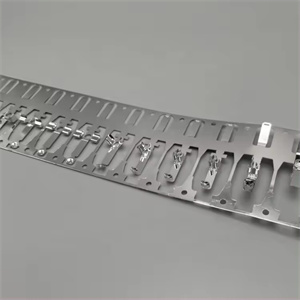Progressive die stamping, also known as transfer die, is a kind of cold stamping die that completes multiple stamping processes at different stations at the same time in one stroke of the press. This kind of mold has the characteristics of high precision, high efficiency and long life, so it is widely used in large-scale production.
In progressive die stamping molds, raw materials are continuously fed into various stations of the mold through a feeding device. Each station is responsible for a specific stamping process, such as punching, trimming, bending, drawing, etc. As the press travels, the raw material passes through the various stations in turn, and finally all the stamping processes are completed and the desired part or product is formed.
The advantages of progressive die stamping molds lie in their high efficiency and degree of automation. Since multiple processes can be completed at the same time in a single stroke, productivity can be greatly improved. In addition, the degree of automation of progressive die stamping molds is also high, which can reduce manual operations, reduce production costs, and improve product consistency and quality.
However, the design and manufacture of progressive die stamping is also more complex, requiring consideration of the coordination and coordination between the various stations, as well as the accuracy of the feeding device and the mold structure. Therefore, progressive die stamping are often used in large-scale production to give full play to their advantages of high efficiency and high quality.
Progressive molds have a wide range of applications in the field of electronic product manufacturing. Electronic products usually have the characteristics of miniaturization, high precision, and complex structure, and progressive molds can adapt well to these needs. For example, in mobile phone manufacturing, progressive molds can be used to produce precision connectors, SIM card holders, and other components inside mobile phones. These components typically require high-precision dimensions and shapes, and progressive dies can ensure consistency and accuracy in each stamping process. For computer components, such as various interfaces on computer motherboards and fins on heat sinks, progressive molds can efficiently complete stamping processing to meet the needs of large-scale production.
In consumer electronics products such as tablets, smartwatches, etc., their casings, buttons, and other components can also be formed by progressive stamping, achieving complex shapes while ensuring good surface quality. In addition, progressive molds can also be used to produce packaging shells for electronic components, such as chip packaging frames, providing assurance for the performance and reliability of electronic products.
